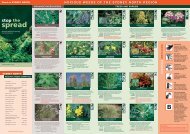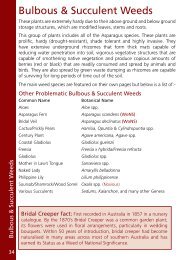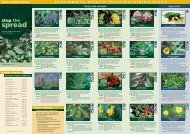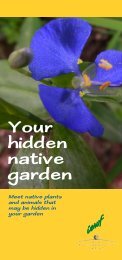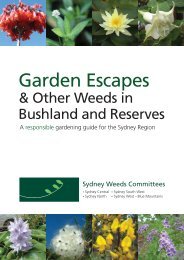African Olive - Sydney Weeds Committees
African Olive - Sydney Weeds Committees
African Olive - Sydney Weeds Committees
- No tags were found...
Create successful ePaper yourself
Turn your PDF publications into a flip-book with our unique Google optimized e-Paper software.
1.0 Cover Page<br />
REGIONAL WEED MANAGEMENT PLAN<br />
1.1 PLAN TITLE: <strong>African</strong> <strong>Olive</strong> Management Plan for the <strong>Sydney</strong> Region.<br />
1.2 PLAN PROPONENTS<br />
Regional <strong>Weeds</strong> Advisory Committee: <strong>Sydney</strong> West Blue Mountains, South West <strong>Sydney</strong>, <strong>Sydney</strong> North and<br />
<strong>Sydney</strong> Central <strong>Weeds</strong> <strong>Committees</strong>.<br />
Address: Liverpool City Council<br />
Contact person: Joel Daniels<br />
Telephone number: 1300 36 2170<br />
Facsimile number: 9821 9333<br />
Email address: J.Daniels@liverpool.nsw.gov.au<br />
Signature: Chairman:............................................................................ Date: .......................<br />
1.3 NAME OF PLANT(S) WONS NO<br />
Botanical name(s):<br />
Common name(s):<br />
Olea europaea subspecies cuspidata <strong>African</strong> <strong>Olive</strong><br />
1.4 PLAN PERIOD<br />
Starting date: 1/7/2008 Completion date: 30/6/2013<br />
1.5 AREA OF OPERATION:<br />
This plan extends over the geographical area represented by the <strong>Sydney</strong> Central, South West <strong>Sydney</strong>, <strong>Sydney</strong><br />
North and <strong>Sydney</strong> West ~ Blue Mountains regional weeds committees.<br />
1.6 AIM: To reduce the environmental impact of <strong>African</strong> <strong>Olive</strong> within the <strong>Sydney</strong> region.<br />
1.7 OBJECTIVES:<br />
1. To identify high, medium and low priority areas of works, based on characteristics such as level of<br />
biodiversity, threatened species, new incursions etc by 2009.<br />
2. To reduce infestations of <strong>African</strong> <strong>Olive</strong> in high priority areas by 2013.<br />
3. To contain infestations of <strong>African</strong> <strong>Olive</strong> in medium and low priority areas by 2013.<br />
4. To seek the declaration of <strong>African</strong> <strong>Olive</strong> as a Class 4 noxious weed in relevant remaining LGAs in the <strong>Sydney</strong><br />
region.<br />
5. To target enforcement activities in high priority areas, and areas adjacent to where works on <strong>African</strong> <strong>Olive</strong> will<br />
be carried out.<br />
6. To increase awareness of the impacts, identification and control methods of <strong>African</strong> <strong>Olive</strong>.<br />
7. To ensure a continued strategic focus to control <strong>African</strong> <strong>Olive</strong> through ongoing; surveys, monitoring, research<br />
and evaluation.<br />
<strong>African</strong> <strong>Olive</strong> Management Plan for the <strong>Sydney</strong> Region Page 1
2.0 STAKEHOLDERS<br />
*LCAs of the four <strong>Sydney</strong> <strong>Weeds</strong> <strong>Committees</strong>, *Department of Environment and Climate Change (DECC),<br />
Hawkesbury Nepean Catchment Management Authority (HNCMA), <strong>Sydney</strong> Metropolitan Catchment<br />
Management Authority (SMCMA), *Department of Lands (DOL), *Department of Housing (DOH), *Botanic<br />
Gardens Trust (Mount Annan Botanic Garden), *<strong>Sydney</strong> Water Corporation (SWC), *RailCorp, Dept of Primary<br />
Industry (DPI), *Roads and Traffic Authority (RTA), *Department of Defence (DOD),<br />
* Key land managers who are critical to the success of this Plan<br />
3.0 BACKGROUND and JUSTIFICATION<br />
Introduced to Australia in the mid 19th century for horticultural purposes, <strong>African</strong> <strong>Olive</strong> is proving to have<br />
serious impacts on the natural environments in the <strong>Sydney</strong> Region. This plan has been developed to coordinate a<br />
regional, strategic approach to managing <strong>African</strong> <strong>Olive</strong> in the <strong>Sydney</strong> region.<br />
<strong>African</strong> <strong>Olive</strong> is an aggressive woody weed, capable of forming a dense and permanent canopy in a wide range of<br />
vegetation types (1) . With over 17 species of birds reported to spread <strong>African</strong> <strong>Olive</strong> (3) , it has been recorded in<br />
every local government area in the <strong>Sydney</strong> region. It is well established on the clay soils in Western <strong>Sydney</strong> with<br />
the worst infestations in the LGAs of Camden, Campbelltown and Wollondilly.<br />
Whilst <strong>African</strong> <strong>Olive</strong> appears to prefer the<br />
clay soils of the Cumberland Plain, it also<br />
has the ability to establish on dry exposed<br />
ridgelines, and grow on high soil moisture<br />
and fertility sites (1) . In the past decades<br />
<strong>African</strong> <strong>Olive</strong> has been noticed to be<br />
spreading rapidly across the <strong>Sydney</strong><br />
landscape and if nothing is done to control<br />
this weed, its impact is likely to increase<br />
dramatically.<br />
Left: The beginning of an<br />
<strong>African</strong> <strong>Olive</strong> infestation<br />
at Mt Annan, 1984 and<br />
Below: <strong>African</strong> <strong>Olive</strong><br />
marching down the same<br />
hill in 2004.<br />
Photos: Peter Cuneo*<br />
Of particular concern is the serious impact<br />
of <strong>African</strong> <strong>Olive</strong> on the Cumberland Plain<br />
bushland of Western <strong>Sydney</strong>. The<br />
Cumberland Plain is among the most<br />
threatened bushland in New South Wales<br />
and has been identified as a priority for<br />
conservation. (5) The native vegetation of<br />
this region has been extensively cleared<br />
since European settlement with only 12 per<br />
cent remaining as intact bushland. (5)<br />
* Peter Cuneo is the<br />
Manager - Natural<br />
Heritage, at Mount<br />
Annan Botanic Garden.<br />
Through his experience<br />
in treating the <strong>African</strong><br />
<strong>Olive</strong>, and his research,<br />
he is currently the<br />
leading expert on <strong>African</strong><br />
<strong>Olive</strong> in the <strong>Sydney</strong><br />
Region.<br />
<strong>African</strong> <strong>Olive</strong> has been reported to pose a<br />
significant threat to the endangered<br />
<strong>African</strong> <strong>Olive</strong> Management Plan for the <strong>Sydney</strong> Region Page 2
ecological communities on the Cumberland Plain, including: Cumberland Plain Woodland; Western <strong>Sydney</strong> Dry<br />
Rainforest and River Flat Eucalypt Forest on Coastal Floodplains (2) .<br />
With 76% of all Cumberland Plain bushland occurring on privately owned land, the declaration of <strong>African</strong><br />
<strong>Olive</strong> in the <strong>Sydney</strong> region is of urgent priority.<br />
The activities of the <strong>Sydney</strong> <strong>Weeds</strong> <strong>Committees</strong> are guided by two Regional <strong>Weeds</strong> Strategies;<br />
The <strong>Sydney</strong> Metropolitan and the Draft Hawkesbury Nepean <strong>Weeds</strong> Strategy. A key action in these strategies<br />
was the prioritisation of weeds. <strong>African</strong> <strong>Olive</strong> ranked the following way for each committee;<br />
o 2 for South West <strong>Sydney</strong><br />
o 9 for <strong>Sydney</strong> West Blue Mountains<br />
o 19 for <strong>Sydney</strong> North<br />
o 20 for <strong>Sydney</strong> Central<br />
The South West <strong>Sydney</strong> <strong>Weeds</strong> Committee in particular have recognised <strong>African</strong> <strong>Olive</strong> as one of the worst<br />
environmental weeds in their region.<br />
The following recommendations were made in Peter Cuneo’s most recent paper on <strong>African</strong> <strong>Olive</strong> (1) ;<br />
- <strong>African</strong> <strong>Olive</strong> can no longer be considered a sleeper weed,<br />
- There is a strong case to declare <strong>African</strong> <strong>Olive</strong> as a Class 4 weed,<br />
- A coordinated strategy for <strong>African</strong> <strong>Olive</strong> is required to prevent future permanent loss of native plant<br />
diversity.<br />
If no action is taken to control <strong>African</strong> <strong>Olive</strong> there will be:<br />
- Continued loss of biodiversity<br />
- Continued impact on endangered ecological communities<br />
- Further spread and establishment across <strong>Sydney</strong><br />
- Continual reinfestation of controlled areas<br />
- Increased cost of control in the future<br />
- Where it is not declared, councils will continue to be powerless to act regarding private property<br />
infestations.<br />
3.1 Distribution of Infestations<br />
<strong>African</strong> <strong>Olive</strong> has been recorded in every LGA in the <strong>Sydney</strong> region. It is considered a widespread weed in the<br />
South West <strong>Sydney</strong> and <strong>Sydney</strong> West Blue Mountains regions and a common weed in the <strong>Sydney</strong> North and<br />
<strong>Sydney</strong> Central region.<br />
The following excerpt has been taken from Peter Cuneo’s <strong>African</strong> <strong>Olive</strong> paper 1 . Also see attached map, on the<br />
following page, which used satellite imagery to map <strong>African</strong> <strong>Olive</strong>.<br />
<strong>African</strong> <strong>Olive</strong> distribution in Western <strong>Sydney</strong> - NSW<br />
The Camden – Campbelltown area on the southern edge of the Cumberland Plain in western <strong>Sydney</strong> is the most<br />
established centre of <strong>African</strong> <strong>Olive</strong> occurrence in Australia. Here historic properties have provided multiple<br />
source locations for the spread of <strong>African</strong> <strong>Olive</strong>, facilitated by frugivorous birds. It was first noted as a potential<br />
problem weed in the area around the mid -1970s, by which time it had formed shrubby thickets on the steeper<br />
<strong>African</strong> <strong>Olive</strong> Management Plan for the <strong>Sydney</strong> Region Page 3
slopes and hills in the Camden – Cobbitty area, particularly on the Razorback Range (Forestry Commission NSW<br />
1976, D. Benson, pers. comm). By the 1980s it was described as a major invading weed of grazing parkland in the<br />
Camden/Campbelltown area (Dellow 1987). The rapid expansion of <strong>African</strong> <strong>Olive</strong> in the Camden –<br />
Campbelltown area from the 1980s has been documented at Mount Annan Botanic Garden. With the cessation of<br />
grazing, <strong>African</strong> <strong>Olive</strong> has spread throughout Mount Annan Botanic Garden beginning with scattered occurrences<br />
over 20 hectares in 1985 to a present coverage of 80 hectares, with some sections now developed into mature<br />
(>15 years age) pure stands on steeper sites.<br />
From established populations in south-west <strong>Sydney</strong>, <strong>African</strong> <strong>Olive</strong> is now spreading northwards to other areas of<br />
the Cumberland Plain, primarily along roadsides and beneath powerlines into the Penrith and Windsor areas.<br />
<strong>African</strong> <strong>Olive</strong> occurs as scattered occurrences in the Kurrajong – Grose Vale area and Scheyville National Park.<br />
In the Ryde LGA, where <strong>African</strong> <strong>Olive</strong> is a declared noxious weed, infestations appear to have originated from<br />
historic plantings at Brush Farm, with current spread now limited to several small bushland parks.<br />
Please refer to the following map showing locations for South Western <strong>Sydney</strong>.<br />
<strong>African</strong> <strong>Olive</strong> Management Plan for the <strong>Sydney</strong> Region Page 4
<strong>African</strong> <strong>Olive</strong> is well-established on the clay soils and hilly terrain of south-western <strong>Sydney</strong>. It is widely established in the Camden<br />
region, and has spread rapidly since the 1980s. Dense infestations now threaten fragmented native vegetation. Source: Landsat 2000<br />
imagery.<br />
<strong>African</strong> <strong>Olive</strong> Management Plan for the <strong>Sydney</strong> Region Page 5
3.2 Weed Biology<br />
Characteristics of <strong>African</strong> <strong>Olive</strong>:<br />
• Native to South Africa<br />
• Shrub or branched tree to about 12 m high. Leaves oblong to elliptic; upper surface glossy grey-green with<br />
a recurved (hooked) tip<br />
• White to cream tubular flowers, flowering in spring at the junction of the leaves and the stem.<br />
• Fruit is (7-10mm) smaller than European <strong>Olive</strong><br />
• Trees at the early mature stage are capable of producing thousands of fruits.<br />
• Spread by bird-dispersed seed.<br />
• Has ability to form dense seedling carpets which provide successive generations of plants.<br />
• Outcompetes established native vegetation, casting dense shade which prevents the regeneration of native<br />
plants.<br />
The following links have the most up to date data on weed biology;<br />
Link: http://www.weeds.org.au<br />
4.0 LEGISLATIVE and REGULATORY SITUATION<br />
4.1 Current Declaration<br />
In the <strong>Sydney</strong> region, <strong>African</strong> <strong>Olive</strong> is currently a declared Class 4 noxious weed under the Noxious <strong>Weeds</strong> Act<br />
1993 in the City of Ryde only.<br />
4.2 Declaration Changes<br />
It is proposed that <strong>African</strong> <strong>Olive</strong> be declared as a Class 4 noxious weed under the Noxious <strong>Weeds</strong> Act 1993 in the<br />
remaining LCAs in the <strong>Sydney</strong> region. This would result in <strong>African</strong> <strong>Olive</strong> being declared noxious and<br />
strategically managed across the entire <strong>Sydney</strong> region.<br />
Whilst some Councils may choose not to declare <strong>African</strong> <strong>Olive</strong> for various reasons, it is anticipated that they will<br />
still be involved in implementing many of the actions in the regional plan.<br />
Some stands of <strong>African</strong> <strong>Olive</strong> will have heritage values for some Councils; exemptions for these will be written<br />
into Class 4 plans.<br />
5.0 CONSIDERATIONS and OPPORTUNITIES<br />
5.1 Financial support to carry out the plan<br />
To assist in the implementation of this plan, funding will be sought from various state and federal government<br />
agencies for on-ground works and developing education and awareness raising programs.<br />
A great deal of work is already being undertaken by councils and other agencies in the <strong>Sydney</strong> region to control<br />
<strong>African</strong> <strong>Olive</strong> and effective control techniques are available. This huge contribution could be used to seek further<br />
funding, improve strategic coordination of projects and provide models for further work in other areas.<br />
<strong>African</strong> <strong>Olive</strong> Management Plan for the <strong>Sydney</strong> Region Page 6
5.2 Species Management<br />
The following information has bee taken from Peter Cuneo’s <strong>African</strong> <strong>Olive</strong> paper (1)<br />
Technique Application method Comments<br />
Cut stump<br />
Plants are sawn off close to ground level and undiluted Glyphosate360 g/l (eg,Roundup®) is<br />
applied (Ensbey 2004) by brush or applicator bottle (within 30 seconds) to the entire stump<br />
APVMA permit 9158).<br />
Plants growing in damp areas or treated during dry<br />
conditions may require special attention as they may<br />
re-shoot (National Trust 1999).<br />
Triclopyr (Garlon 600® - reg label 31898) and diesel mixture (1:14) (Ensbey 2004) is also<br />
highly effective as a “cut and paint” application(Dellow 1987),<br />
Foliar Spray Spray control of seedlings and coppice shoots using Glyphosate 360g/ldiluted at 1:75 or 1:100<br />
rate (Ensbey 2004) (APVMA permit 9158).<br />
Effectiveness is highly variable. Ziesing (1997)<br />
reports increased effectiveness in seedling control<br />
with the addition of Urea in spray tank.<br />
Tree injection<br />
Basal bark spray<br />
Portable drills are used to drill 3 cm deep holes into the trunk at a 45degree angle, spaced 4 cm<br />
apart. Undiluted Glyphosate 360 g/l at a rate of 2.5 ml per hole is injected into each hole using<br />
an applicator bottle or backpack injection unit (APVMA permit 9158). Frilling technique is<br />
similar, with chisels used instead of portable drills to create an opening at regular intervals in the<br />
trunk for the injection of glyphosate.<br />
Garlon® (Triclopyr) diluted in diesel oil applied to the first 30 cm of trunk, wetting the bark to<br />
runoff point. In NSW & SA, Garlon® is registered for use on <strong>Olive</strong> as both a cut stump and<br />
basal bark application at a rate of 1:14 with diesel oil (Reg label 31898).<br />
This is commonly used to control <strong>African</strong> <strong>Olive</strong> in<br />
inaccessible areas, such as olive “halos” around large<br />
Eucalypt perch trees, where cutting and removal of<br />
material is not practical. <strong>African</strong> <strong>Olive</strong>s are left in<br />
situ and can be useful in maintaining temporary<br />
habitat for small native birds.<br />
Simple-to-apply technique, outstanding in<br />
controlling olive regardless of size (Dellow 1987).<br />
Cost effective, but best done by experienced<br />
personnel with spray equipment fitted with Viton®<br />
seals (resistant to mineral oils). Care is required to<br />
prevent soil contamination in bushland areas.<br />
Fire Young olive plants
<strong>African</strong> <strong>Olive</strong> Management Plan for the <strong>Sydney</strong> Region Page 8
5.3 Extension and Education<br />
The main focus for education and extension activities will be to increase skills in the identification and control of<br />
<strong>African</strong> <strong>Olive</strong> by both residents and local and state agency staff. This will be achieved through numerous means<br />
such as:<br />
• High profile media campaign when <strong>African</strong> <strong>Olive</strong> is declared in local newspapers.<br />
• Articles in Mayoral columns.<br />
• Distribute information to agency staff on <strong>African</strong> <strong>Olive</strong> identification and management, especially<br />
regulatory officers, health and building / development control officers and parks staff.<br />
• Including <strong>African</strong> <strong>Olive</strong> in weed displays.<br />
• Including <strong>African</strong> <strong>Olive</strong> in regional weed brochures, WEEDeck and the committees’ website.<br />
5.4 Links to other Strategies<br />
The plan is a direct outcome of both the Draft Hawkesbury Nepean and <strong>Sydney</strong> Metropolitan <strong>Weeds</strong><br />
Strategies, the strategies which guide the actions of the <strong>Sydney</strong> <strong>Weeds</strong> <strong>Committees</strong>.<br />
The plan meets several 'Desired Outcomes' of the NSW <strong>Weeds</strong> Strategy:<br />
• The development and implementation of programs to reduce environmental degradation and the loss of<br />
biodiversity through weed invasions;<br />
• The implementation and monitoring of weed control programs on public and State-owned and Crown<br />
Land to ensure that objectives are achieved in an efficient and cost effective manner;<br />
• An effective and efficient system for delivery of noxious weeds control and the enforcement of weeds<br />
legislation.<br />
It also conforms to the Mission Statement for the National <strong>Weeds</strong> Strategy; "to reduce the detrimental impact of<br />
weeds on the sustainability of Australia's productive capacity and natural ecosystems", and to Objective 3.2;<br />
‘encourage the development of strategic plans for weed management at all levels’.<br />
The plan also contributes to the Natural Resource Commissions (NRC) Statewide target; ‘By 2015 there is a<br />
reduction in the impact of invasive species’.<br />
5.5 Barriers and Contingencies<br />
The following barriers were identified in meeting the objectives of this plan, these have been considered and<br />
contingencies have been incorporated into the action plan.<br />
1. Reluctance of landholders to control <strong>African</strong> <strong>Olive</strong> (Action 6.10, 6.11 & 6.12)<br />
2. Control is often not coordinated with neighbouring landowners, which reduces effectiveness (Actions 6.10<br />
6.12)<br />
3. Cost of control can be significant for residents (Action 6.12)<br />
4. Cost of control on public land is significant due to large extent of infestations (Actions 6.2, 6.3, 6.6 & 6.7)<br />
5. Lack of awareness and skills in <strong>African</strong> <strong>Olive</strong> identification and control, and its impacts to the<br />
environment (Action 6.11).<br />
<strong>African</strong> <strong>Olive</strong> Management Plan for the <strong>Sydney</strong> Region Page 9
6.0 ACTION PLAN<br />
ACTION PLAN FOR CONTROL PERFORMANCE INDICATOR WHO ADDRESSES<br />
WHICH<br />
OBJECTIVES<br />
(Number)<br />
Surveying, Monitoring and evaluation<br />
6.1 Carry out broad scale mapping of <strong>African</strong><br />
<strong>Olive</strong> using satellite imagery or aerial photo<br />
interpretation, for the <strong>Sydney</strong> region.<br />
6.2 Determine high, medium and low priority<br />
areas of works., based on characteristics such as<br />
level of biodiversity, threatened species, new<br />
incursions etc<br />
Broad scale mapping carried out by 2009<br />
Priority areas of works determined by 2010<br />
<strong>Sydney</strong> <strong>Weeds</strong><br />
<strong>Committees</strong><br />
<strong>Sydney</strong> <strong>Weeds</strong><br />
<strong>Committees</strong><br />
6.3 Determine adequate containment lines. Containment lines identified by 2010 <strong>Sydney</strong> <strong>Weeds</strong><br />
<strong>Committees</strong><br />
6.4 Record areas of works at a regional level GIS is used to collect information on locations of <strong>Sydney</strong> <strong>Weeds</strong><br />
using GIS.<br />
works being carried out by 2010<br />
<strong>Committees</strong><br />
1<br />
1<br />
1<br />
7<br />
6.5 Review <strong>African</strong> olive plan to incorporate new<br />
information and data.<br />
Area of works updated by 2013<br />
<strong>African</strong> olive plan reviewed and any new<br />
information incorporated by 2012.<br />
<strong>Sydney</strong> <strong>Weeds</strong><br />
<strong>Committees</strong><br />
7<br />
On-ground works<br />
6.6 Carry out control works to reduce <strong>African</strong><br />
<strong>Olive</strong> in high priority areas on public land (eg.<br />
High biodiversity sites, bush regen sites, new<br />
incursions.<br />
6.7 Carry out works to contain <strong>African</strong> olive in<br />
medium and low priority areas on public land.<br />
6.8 Carry out works to contain <strong>African</strong> <strong>Olive</strong> to<br />
broadscale containment lines.<br />
Works in high priority areas on public land begin<br />
by 2009<br />
Containment works in med and low priority areas<br />
on public land begin by 2010<br />
Works to contain <strong>African</strong> <strong>Olive</strong> within<br />
containment lines begin by 2010<br />
<strong>Sydney</strong> –wide LCAs,<br />
state agencies <strong>Sydney</strong><br />
<strong>Weeds</strong> <strong>Committees</strong>,<br />
bushcare.<br />
<strong>Sydney</strong> – wide LCAs,<br />
state agencies <strong>Sydney</strong><br />
<strong>Weeds</strong> <strong>Committees</strong>,<br />
bushcare<br />
<strong>Sydney</strong> – wide LCAs,<br />
state agencies<br />
2<br />
3<br />
3<br />
<strong>African</strong> <strong>Olive</strong> Management Plan for the <strong>Sydney</strong> Region Page 10
Enforcement<br />
6.9 Send submissions to NWAC for <strong>African</strong><br />
<strong>Olive</strong> Class 4 declaration in all relevant LCAs<br />
across the region.<br />
<strong>African</strong> <strong>Olive</strong> declared in 70% of the LCAs in the<br />
<strong>Sydney</strong> region by June 2013.<br />
<strong>Sydney</strong> – wide LCAs 4<br />
6.10 Target enforcement activities on private land<br />
within high priority areas or areas where works<br />
are being carried out on land adjacent.<br />
Proactive inspection programs implemented in<br />
high priority areas and around areas where works<br />
are being carried out on land adjacent.<br />
<strong>Sydney</strong> – wide LCAs,<br />
private landholders<br />
5<br />
Education<br />
6.11 Provide information and increase technical<br />
skills for the community and LCA staff, in<br />
<strong>African</strong> <strong>Olive</strong> identification and appropriate<br />
control.<br />
Media blitz when <strong>African</strong> <strong>Olive</strong> is declared in<br />
local newspapers.<br />
Articles in Mayoral columns.<br />
<strong>Sydney</strong> wide LCAs,<br />
DECC, DPI, <strong>Sydney</strong><br />
<strong>Weeds</strong> <strong>Committees</strong><br />
6<br />
Distribute information to agency staff on <strong>African</strong><br />
<strong>Olive</strong> identification and management, especially<br />
regulatory officers, health and building /<br />
development control officers and parks staff.<br />
Include <strong>African</strong> <strong>Olive</strong> in weed displays and at<br />
other times in conjunction with local festivals,<br />
tree giveaways, etc.<br />
6.12 Implement incentives programs to encourage<br />
proactive private property control of <strong>African</strong><br />
<strong>Olive</strong><br />
Include <strong>African</strong> <strong>Olive</strong> in regional weed<br />
brochures, WEEDeck and the committees’<br />
website.<br />
LCAs, DECC and CMAs are encouraged to<br />
implement incentives programs.<br />
Incentives programs implemented to control<br />
<strong>African</strong> <strong>Olive</strong> on private land.<br />
<strong>Sydney</strong> – wide LCAs,<br />
CMAs, DECC,<br />
<strong>Sydney</strong> <strong>Weeds</strong><br />
<strong>Committees</strong>, private<br />
landholders.<br />
6<br />
<strong>African</strong> <strong>Olive</strong> Management Plan for the <strong>Sydney</strong> Region Page 11
7.0 MONITOR and REVIEW PROCESS<br />
This plan is designed to be monitored and reviewed on an ongoing basis. Mapping has been incorporated into the<br />
plan to both determine the extent of <strong>African</strong> <strong>Olive</strong> infestations and to record areas of works by members of the<br />
<strong>Sydney</strong> <strong>Weeds</strong> <strong>Committees</strong>, this will initially be completer by 2010 and then updated again in 2013.<br />
Council and agency staff will also carry out monitoring on the ground via there regular field inspections and<br />
progress meetings with contractors.<br />
Please refer to surveying, monitoring and evaluation section in action plan.<br />
8.0 BENEFITS<br />
Controlling <strong>African</strong> <strong>Olive</strong> will have a positive effect on biodiversity conservation in the region, by protecting the<br />
species integrity of remnant bushland areas and revegetated habitat corridors. Of particular benefit will be the<br />
reduction in the impact of <strong>African</strong> <strong>Olive</strong> on the endangered ecological communities of the Cumberland Plain.<br />
9.0 RESOURCES<br />
1. Cuneo, P. & Leishman, M.R. (2006): <strong>African</strong> <strong>Olive</strong> (Olea europaea subsp. cuspidata) as an environmental<br />
weed in eastern Australia: a review. Cunninghamia 9(4): 545-577.<br />
URL : http://www.rbgsyd.nsw.gov.au/__data/assets/pdf_file/81638/Cun94Cun545sm.pdf<br />
2. Tozer, M (2003): The native vegetation of the Cumberland Plain, western <strong>Sydney</strong>: Systemic classification and<br />
field identification of communities. Cunninghamia 8(1): 1 – 75.<br />
2. Johnson, S. & Lisle, S (2007): Issues posed by Feral <strong>Olive</strong>s in New South Wales. NSW DPI<br />
3. NSW Scientific Committee (2000) Western <strong>Sydney</strong> dry rainforest in the <strong>Sydney</strong> Basin Bioregion -<br />
Endangered ecological community determination - final. DEC (NSW), <strong>Sydney</strong>.<br />
4. Department of Environment and Conservation (NSW). (2005): Recovering Bushland on the Cumberland<br />
Plain: Best practice guidelines for the management and restoration of bushland. Department of Environment<br />
and Conservation (NSW), <strong>Sydney</strong>.<br />
Best practice guidelines for the management and restoration<br />
<strong>African</strong> <strong>Olive</strong> Management Plan for the <strong>Sydney</strong> Region Page 12



